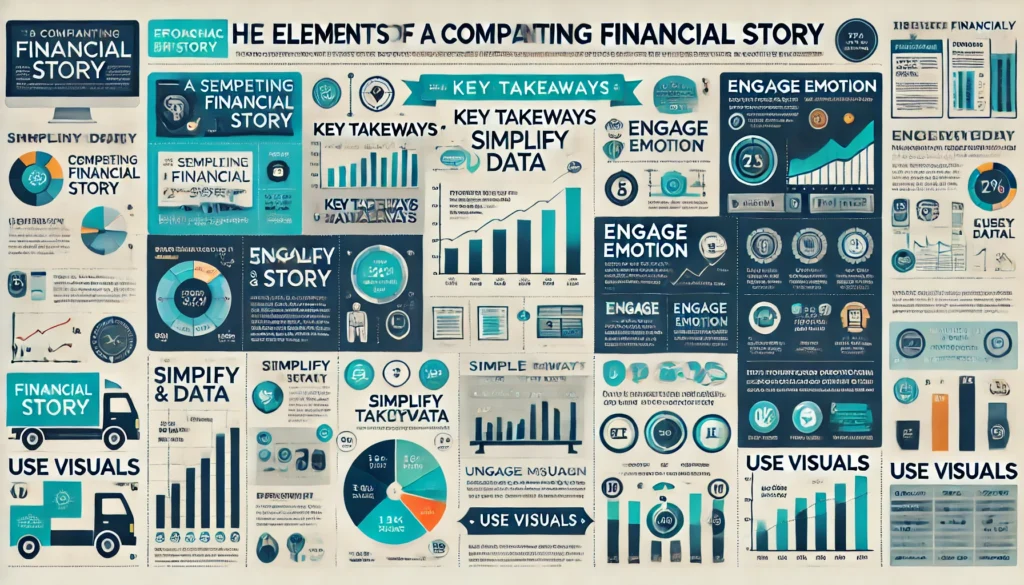The Art of Storytelling in Finance Presentations
Introduction
Storytelling is as ancient as human civilization itself. Humans have used stories to pass down knowledge, share experiences, and inspire action for centuries. Today, storytelling extends beyond literature and entertainment; it plays a vital role in business, education, and finance. While financial data often seems dull, cold, and intimidating, storytelling transforms it into a relatable and engaging narrative. By blending the art of storytelling with the science of numbers, finance professionals can captivate their audience, simplify complex concepts, and drive their points home.
Imagine sitting through a finance presentation filled with endless spreadsheets, bar graphs, and technical jargon. Chances are, you’d find it overwhelming or, worse, mind-numbingly boring. But now, picture a presenter weaving a story about a struggling small business that turned its fortunes around through smart financial planning—suddenly, the data has life.
This blog explores the transformative power of storytelling in finance presentations. Whether you’re a seasoned professional, a student, or someone with a casual interest in finance, this guide will inspire you to embrace storytelling and make your presentations memorable.
Key Benefits of Storytelling in Finance Presentations
- Humanizes the Data
Data by itself is abstract, but storytelling creates a human connection. For example, instead of stating “Revenue grew by 15%,” narrate the journey of how strategic decisions led to that growth, highlighting the challenges and triumphs along the way. - Simplifies Complex Concepts
Financial concepts like depreciation, capital allocation, or liquidity ratios can be intimidating. A well-crafted story with metaphors or real-life examples can break down these ideas into digestible bits, making them easier to understand. - Enhances Retention
Research shows that people are more likely to remember stories than raw data. Incorporating stories ensures your audience recalls the key points long after the presentation ends. - Inspires Action
Stories evoke emotions, which can motivate your audience to take action—whether it’s implementing new financial strategies or approving a proposed budget.
Techniques to Incorporate Storytelling
- Start with a Hook
Open your presentation with an intriguing anecdote, statistic, or hypothetical scenario to capture your audience’s attention. - Frame Data with Context
Every chart or graph should be accompanied by a narrative that explains the “why” and “how” behind the numbers. - Use Characters and Conflict
Introduce relatable characters, such as a client or company, and describe the financial challenges they faced. Then, detail how they overcame those challenges, emphasizing your key points. - Leverage Visual Storytelling
Pair your story with visuals, like infographics or videos, to make your message even more compelling. - End with Impact
Close your presentation with a powerful conclusion that ties the story together and reinforces your main takeaway.

The Art of Storytelling in Finance Presentations
1. Why Storytelling in Finance?
Numbers tell a story, but it’s not always a story people can easily understand or connect with. Finance, by nature, is dense and data-heavy. It involves statistics, projections, and ratios that, while crucial, can easily disengage an audience. Storytelling bridges the gap between cold data and human connection, turning numbers into narratives that resonate with listeners.
One of the primary reasons storytelling is vital in finance is its ability to make information relatable. Financial decisions impact real people and their lives. Whether it’s a family planning their retirement, a startup seeking investment, or a corporation presenting quarterly earnings, the human element is always present. Storytelling brings humanity to the forefront, making the information understandable and memorable.
Consider the case of Warren Buffett, one of the world’s most successful investors. His annual letters to shareholders are legendary not just for their financial insights but for their storytelling. Instead of relying solely on dense financial data, Buffett uses analogies, personal anecdotes, and relatable scenarios to communicate complex financial strategies. This approach has cemented his reputation as an economic genius and made his messages accessible to a broad audience.
Moreover, storytelling in finance helps to overcome the challenge of audience engagement. Many people have a natural aversion to financial discussions, often perceiving them as complicated or uninteresting. A well-told story, however, can capture their attention and keep them engaged. For instance, a presenter discussing a company’s growth can highlight the struggles and triumphs behind those numbers, creating an emotional connection that motivates the audience to listen and understand.

Why Storytelling in Finance?
In essence, storytelling in finance is about more than just presenting data. It’s about transforming that data into a narrative that informs, inspires, and drives action. The next sections will dive into the key elements of effective financial storytelling and how to master this art.
2. Elements of a Compelling Story in Finance Presentations
Crafting a compelling story in finance involves more than just sharing facts and figures. It requires a deliberate effort to structure and present information in a way that resonates with the audience. Here are the key elements of a powerful financial story:
1. The Hero’s Journey
Every great story has a hero, and in financial storytelling, the hero can be your client, your company, or even your audience. The hero’s journey involves a quest—a problem or challenge that needs to be overcome. For example, if you’re presenting a financial turnaround strategy, you can position the company as the hero overcoming adversity. This narrative structure creates a sense of purpose and progression, making your presentation more engaging and relatable.
2. Conflict and Resolution
No story is complete without conflict. In finance, conflict could be a market downturn, budget constraints, or a failed investment. Highlighting these challenges adds tension and resolves
—your proposed financial solution—more impactful. Conflict keeps your audience emotionally invested, while the resolution provides a satisfying conclusion that demonstrates the value of your financial insights.
3. Emotional Appeal
Numbers alone rarely evoke emotions, but the stories behind them do. For instance, instead of simply stating that a company increased its revenue by 20%, share the story of how that revenue growth allowed the company to provide jobs for 500 more families. Emotional appeal not only makes your presentation more compelling but also helps your audience remember your message long after the presentation ends.
4. Visual Storytelling
A picture is worth a thousand words, and in finance, visual aids like graphs, charts, and infographics can significantly enhance storytelling. But visual storytelling goes beyond merely presenting data visually; it’s about using visuals to support and enhance your narrative. For instance, a line graph showing steady growth over time can symbolize resilience and success, reinforcing the positive story you’re telling.

Visual Storytelling
5. Simplicity and Clarity
The best stories are simple and easy to follow. Avoid overwhelming your audience with excessive data or overly technical language. Instead, focus on key takeaways and present them in a clear, concise manner. A well-crafted story doesn’t just inform—it simplifies complex ideas and makes them accessible to everyone.
By incorporating these elements into your financial presentations, you can create stories that captivate and inspire your audience, making your message truly unforgettable.

Simplicity and Clarity
3. Techniques to Master Storytelling in Finance
Storytelling in finance is both an art and a skill. Here are some practical techniques to help you master it:
1. Craft a Narrative Around Key Takeaways
Before diving into the details, identify the key messages you want your audience to remember. Build your story around these takeaways, ensuring that every point you make supports your overarching narrative. For example, if your key message is about the importance of diversification in investment, structure your story around how diversification has historically mitigated risks and enhanced returns.
2. Use Metaphors and Analogies
Finance can be intimidating, especially for those unfamiliar with its terminology. Metaphors and analogies simplify complex concepts by relating them to everyday experiences. For instance, you might compare a balanced investment portfolio to a well-balanced diet, emphasizing the importance of variety and moderation. These comparisons help your audience grasp abstract ideas more easily.
Metaphors and Analogies
3. Leverage the Power of Suspense
Good stories keep the audience on the edge of their seats. In finance, you can create suspense by presenting a problem or challenge first, then gradually revealing the solution. For example, instead of immediately disclosing a company’s impressive profit margins, start by describing the tough market conditions it faced, then build up to how strategic decisions led to success.
4. Practice the Art of Repetition
Repetition reinforces key points and ensures your message sticks. Repeat your central theme or takeaway at strategic points throughout your presentation, such as at the beginning, middle, and end. For example, if your story revolves around the theme of “smart risk management,” reiterate this idea in different contexts to drive it home.
5. Engage Your Audience
Effective storytelling is a two-way street. Encourage audience participation by asking questions, inviting feedback, or sharing relatable anecdotes. For instance, you could start your presentation by asking, “How many of you have ever been overwhelmed by financial jargon?” This creates a sense of connection and makes your presentation more interactive.

Engage Your Audience
6. Practice, Revise, and Refine
Storytelling is a skill that improves with practice. Rehearse your presentation multiple times, paying attention to your pacing, tone, and delivery. Seek feedback from colleagues or mentors and revise your story accordingly. The more you refine your storytelling techniques, the more impactful your presentations will become.
By mastering these techniques, you can elevate your financial presentations from mundane to memorable, leaving a lasting impression on your audience.

Practice, Revise, and Refine
4. Common Pitfalls to Avoid
Even the most experienced storytellers can fall into traps that undermine their message. Here are some common pitfalls to avoid:
1. Overloading with Data
While data is essential in finance, too much of it can overwhelm your audience. Avoid the temptation to include every statistic or chart. Instead, focus on the most relevant data that supports your story. Remember, less is often more when it comes to keeping your audience engaged.
2. Ignoring the Emotional Aspect
Finance is inherently analytical, but ignoring the emotional aspect of storytelling can make your presentation feel cold and impersonal. Always strive to connect with your audience on an emotional level by sharing relatable stories, highlighting human impact, or emphasizing the significance of your message.
3. Failing to Tailor the Message
Different audiences have different needs and preferences. Failing to tailor your message to your specific audience can lead to disengagement. For example, a presentation for seasoned investors might focus on technical analysis, while a presentation for a general audience should prioritize simplicity and clarity.
4. Neglecting Visual Aesthetics
Poorly designed visuals can detract from your story and confuse your audience. Ensure your slides, charts, and graphics are clean, professional, and easy to understand. Use consistent fonts, colors, and layouts to create a polished and cohesive visual narrative.

Neglecting Visual Aesthetics
Avoiding these pitfalls will help you deliver a polished, effective, and engaging financial presentation that resonates with your audience.
5. Inspiring Success Stories
Nothing illustrates the power of storytelling in finance better than real-world examples. Here are some inspiring success stories that showcase the impact of financial storytelling:
1. Warren Buffett’s Annual Letters
As mentioned earlier, Warren Buffett’s annual letters to Berkshire Hathaway shareholders are a masterclass in financial storytelling. By blending humour, personal anecdotes, and simple language, Buffett transforms complex financial data into relatable and inspiring messages. His ability to tell a compelling story has earned him the trust and admiration of millions of investors worldwide.
2. Airbnb’s Investor Pitch
When Airbnb was a fledgling startup, its founders used storytelling to secure funding. Instead of bombarding investors with technical jargon and data, they shared the story of how they hosted guests during a design conference to make ends meet. This relatable and engaging narrative helped potential investors see the value and potential of their business, leading to a successful funding round.

Airbnb’s Investor Pitch
3. Steve Jobs’ Keynote Speeches
Although not a traditional finance example, Steve Jobs’ keynote speeches demonstrate the power of storytelling in business presentations. Jobs didn’t just present product specs; he told stories about how Apple’s innovations would change people’s lives. His storytelling approach captivated audiences and solidified Apple’s reputation as a visionary company.
These success stories highlight the transformative impact of storytelling in finance and beyond. By learning from these examples, you can craft stories that inspire confidence and drive results.
Conclusion
In today’s data-driven world, storytelling is more important than ever, especially in finance presentations. It’s not just about presenting numbers; it’s about making those numbers meaningful, relatable, and memorable. By incorporating storytelling into your financial presentations, you can captivate your audience, simplify complex concepts, and inspire action. Whether you’re addressing a room full of professionals, students, or the general public, storytelling is the key to making your message resonate.
So, the next time you prepare a finance presentation, remember: that every number has a story. It’s up to you to tell it. Embrace the art of storytelling and transform your financial data into powerful narratives that leave a lasting impact. Start telling your financial story today!

The Art of Storytelling in Finance Presentations
Lorem ipsum dolor sit amet, consectetur adipiscing elit. Ut elit tellus, luctus nec ullamcorper mattis, pulvinar dapibus leo.
Satyanarayana Dora is a senior professional who worked with different industries. He is a Chartered Accountant from India. He writes about leadership skills, recent updates, career progress path etc...